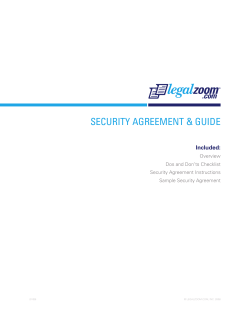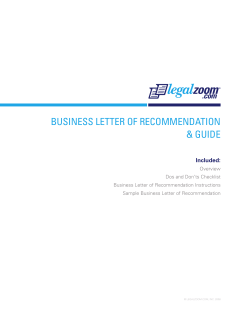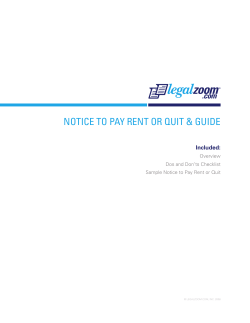
ASSIGNMENT AND ASSUMPTION AGREEMENT & GUIDE Included:
ASSIGNMENT AND ASSUMPTION AGREEMENT & GUIDE Included: Overview Dos and Don’ts Checklist Assignment and Assumption Agreement Instructions Sample Assignment and Assumption Agreement © LEGALZOOM.COM, INC. 2008 1. Overview After a contract has been signed, a change in business climate or in a party’s liquidity can necessitate an assignment of that agreement. If both of the original parties agree to the change and sign documents transferring existing interests and obligations, an agreement can be assigned and assumed by a third party. A company can lose its footing in the marketplace, or local laws can leave one party unable to complete its obligations under an agreement. Rather than leave parties shackled to a dated or impractical agreement, an assignment allows for the substitution of parties better able to respond to a contract’s goals and requirements. The assignment process itself allows for continuing dialogue between the parties, a fact that develops and solidifies successful business relationships. This package contains everything you’ll need to assign your agreement and have it assumed by a third party. A written assignment minimizes confusion, misunderstanding, and error, and sets forth all of the parties’ expectations and fulfillment obligations. In every way, this promotes successful and profitable business arrangements and allows a company to extract itself gracefully from an unfeasible situation. 2. Dos & Don’ts Checklist Read the original agreement to make sure that you and the other party have complied with all of its requirements for assignments and assumptions. Some contracts have specific rules about what types of assignments will be permitted, to whom, and how the process should work. Allow each party to spend some time reviewing both the original agreement and the assignment. This will reduce the likelihood, or at least the efficacy, of a claim that a party did not understand any terms or how those might affect the agreement or their rights and responsibilities. Both parties should review the assignment carefully to ensure that all relevant deal points have been included. It is better to be over-inclusive than under-inclusive. Do not assume that certain expectations or terms are agreed to if they are not stated expressly in the document. The terms of the original agreement are still in effect, so make sure both original parties continue to perform their obligations under that contract until the assignment is completed and signed. Sign three copies of the assignment, one for you and one for each of the other parties. Keep your copy of the signed assignment with the original agreement it modified. Once the assignment is drafted and signed, it is part of the original agreement and should be treated accordingly. Depending on the nature of its terms, you may decide to have your assignment witnessed or notarized. This will limit later challenges to the validity of a party’s signature. If your assignment is complicated, do not use the enclosed form. Contact an attorney to help you draft a document that will meet your specific needs. ASSIGNMENT AND ASSUMPTION AGREEMENT © LEGALZOOM.COM, INC. 2008 1 3. Assignment and Assumption Agreement Instructions The following provision-by-provision instructions will help you understand the terms of your assignment and assumption agreement. The numbers below (e.g., Section 1, Section 2, etc.) correspond to the provisions in the contract. Please review the document in its entirety before starting the step-by-step process. • Introduction. Identifies the document as the assignment and assumption of an existing agreement. Write in the date on which the original agreement was signed. Identify the parties and the date of the amendment. The Assignor must be the same as one of the parties who signed the original agreement (unless the new signer is an agent of that same company). • Recitals. Identifies the existing agreement that’s being modified and explains where the parties’ right to assign the document comes from. Put in the effective date of the original agreement and the section number of that agreement that allows you to assign it. The title of this section is usually “Assignments” or “Modifications.” • Section 1: Assignment. The party that is assigning its interest indicates here that this is its desire. • Section 2: Assumption. The party that is accepting the assignment indicates here that it is willing to take on (“assume”) those rights and responsibilities. • Section 3: Company’s Consent and Release. The consent of the other original party to the assignment and assumption. • Section 4: Inconsistency. Indicates that if there is a conflict between assignment language and the language of the original agreement, the assignment language will be the final word on the question. • Section 5: Agreement Continuance. This serves as an “affirmation” of the original agreement. In other words, the only things that change in the original agreement are the parties that have assigned their interest. All of the other terms of the original agreement remain effective. • Section 6: Indemnification. This provision allocates responsibilities among all of the parties. Essentially, it says that the Assignor is responsible for things that happened before the assignment’s effective date, and the Assignee is responsible for things that happened after the assignment’s effective date. • Section 7: No Release. An explanation that even if one party is assigning its interest, the other party to the original agreement can still hold that party liable for its actions before the assignment. • Section 8: Modification. Indicates that any changes to the document will be in writing and signed by all of the parties. • Section 9: Authority. A promise that the parties signing the agreement have the right and power to do so. • Section 10: Governing Law. Your original agreement probably includes a choice-of-law provision that governs what laws will be used to interpret it. If it does not, this section allows the parties to choose those laws. Note that this is not a venue provision: the included language will not impact where a potential claim can be brought. ASSIGNMENT AND ASSUMPTION AGREEMENT © LEGALZOOM.COM, INC. 2008 2 • Section 11: Counterparts/Electronic Signatures. The title of this provision sounds complicated, but it is simple to explain. It says that even if the parties sign the assignment in different locations, or use electronic devices to transmit signatures (e.g., fax machines or computers), all of the separate pieces will be considered part of the same agreement. In a modern world where signing parties are often not in the same city - much less the same room - this provision ensures that business can be transacted efficiently, without sacrificing the validity of the agreement as a whole. • Section 12: Severability. Protects the terms of the agreement as a whole, even if one part is later invalidated. • Section 13: Entire Agreement. The parties’ agreement that the assignment they’re signing (when taken together with the original agreement) is “the agreement” about the issues involved. Unfortunately, the inclusion of this provision will not prevent a party from arguing that other enforceable promises exist, but it will provide you some protection from these claims. • Section 14: Headings. Notes that the headings at the beginning of each section are meant to organize the document, and should not be considered operational parts of the agreement. DISCLAIMER LegalZoom is not a law firm. The information contained in the packet is general legal information and should not be construed as legal advice to be applied to any specific factual situation. The use of the materials in this packet does not create or constitute an attorney-client relationship between the user of this form and LegalZoom, its employees or any other person associated with LegalZoom. Because the law differs in each legal jurisdiction and may be interpreted or applied differently depending on your location or situation, you should not rely upon the materials provided in this packet without first consulting an attorney with respect to your specific situation. The materials in this packet are provided "As-Is," without warranty or condition of any kind whatsoever. LegalZoom does not warrant the materials' quality, accuracy, timeliness, completeness, merchantability or fitness for use or purpose. To the maximum extent provided by law, LegalZoom, it agents and officers shall not be liable for any damages whatsoever (including compensatory, special, direct, incidental, indirect, consequential, punitive or any other damages) arising out of the use or the inability to use the materials provided in this packet. ASSIGNMENT AND ASSUMPTION AGREEMENT © LEGALZOOM.COM, INC. 2008 3 Form Sample ASSIGNMENT AND ASSUMPTION AGREEMENT © LEGALZOOM.COM, INC. 2008 4
© Copyright 2025





















